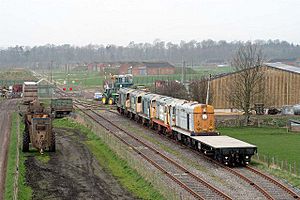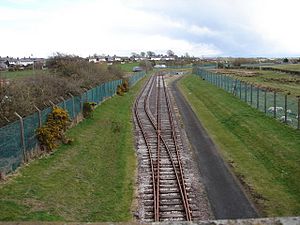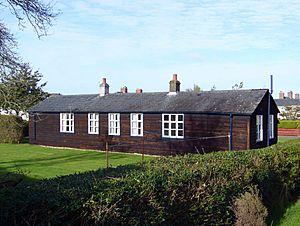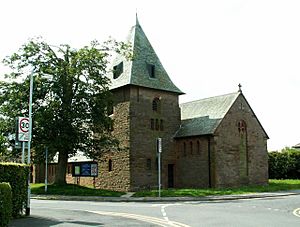HM Factory, Gretna facts for kids


H. M. Factory, Gretna was Britain's largest factory for making cordite during World War I. Cordite is a type of explosive used in bullets and shells. This huge factory was owned by the government and was located near Gretna, Dumfries and Galloway, right next to the Solway Firth.
It was built by the Ministry of Munitions, a special government department, because of the Shell Crisis of 1915. This crisis meant Britain didn't have enough ammunition for its soldiers. The factory cost a lot of money to build, about £9 million in 1915, which would be many times more today. It covered a massive area of 9,000 acres (about 3,600 hectares).
The factory produced cordite worth £15 million between 1916 and 1918. Without it, Britain would have had to buy cordite from the USA at a much higher price. Today, The Devil's Porridge Museum in Eastriggs, Dumfriesshire, helps people remember the amazing efforts of the workers at this factory during World War I.
Contents
Factory Layout and Design
H. M. Factory, Gretna was incredibly long, stretching about 9 miles (14.5 km) from Mossband near Longtown in the east, all the way to Dornock and Eastriggs in the west. It even crossed the border between Scotland and England!
The factory had four main production areas and two special towns built just for the workers. It was like a small city, with its own transport system, power supply, and water system.
Main Production Sites
- Site 1, called Smalmstown, was located north of Longtown.
- Site 2, Mossband, was next to the Caledonian Railway (now the West Coast Main Line) and the River Esk.
- Site 3, Eastriggs, was bordered by the B721 road and the Glasgow and South Western Railway to the north, and the Solway Firth and River Sark to the south.
- Site 4, Gretna, was similar to Site 3 but was right next to the town of Gretna.
Factory Infrastructure
To move materials and supplies around the huge factory, a special narrow gauge railway was built. This railway had 125 miles (200 km) of track and used 34 engines!
Electricity for the factory and the new towns came from its own coal-fired power station. The factory's telephone system was very busy, handling up to 2.5 million calls in 1918. The towns also had their own bakeries, a laundry, and even a police force. The laundry could clean 6,000 items every day, and the bakeries made 14,000 meals daily.
Water for the factory came from the River Esk, north of Longtown. It was pumped through large pipes to a reservoir. A special treatment plant could clean and prepare up to ten million gallons (45,000 cubic meters) of water each day.
History of H. M. Factory, Gretna
Building H. M. Factory, Gretna began in November 1915. Thousands of workers, many of them Irish navvies (laborers), worked on the site. They also built the two wooden towns in Gretna and Eastriggs to house all the new factory workers. To help manage the large number of people and prevent problems, the government took control of pubs and breweries nearby. This was part of a plan called the State Management Scheme.
Production and Workforce
The factory started making ammunition in April 1916. Engineers and chemists from all over the British Empire came to help set up the production of RDB Cordite, a specific type of cordite.
By 1917, most of the workers were women. There were 11,576 women compared to 5,066 men. These women munitions workers became known as The Gretna Girls.
At its busiest, the factory produced 1,400 tonnes of cordite every week. This was more than all the other munitions factories in Britain combined!
The "Devil's Porridge"
Cordite was often called the "Devil's Porridge." This nickname came from the famous writer Sir Arthur Conan Doyle, who visited the factory in 1916. He wrote about how nitroglycerin and gun-cotton were mixed together, saying it was "kneaded into a sort of a devil's porridge." He also noted that the smiling women handling this dangerous mixture would be "blown to atoms in an instant" if something went wrong.
In 1917, when the factory was making 800 tons of cordite each week, King George V and Queen Mary even came to visit.
Factory Closure
Cordite production stopped soon after World War I ended in November 1918. Many workers lost their jobs in December 1918, and the factory officially closed in August 1919. By then, only about 3,000 to 4,000 workers remained.
In 1919 and 1920, the factory buildings were taken down. Although the entire factory site was kept for a few years, much of it was eventually sold off for farming and other private uses. The towns of Eastriggs and Gretna, along with their bakeries, were also sold.
After H. M. Factory, Gretna closed, the Waltham Abbey Royal Gunpowder Mills near London became the only government-owned cordite factory until World War II began.
Notable People Connected to H. M. Gretna
Many interesting people worked at or visited H. M. Factory, Gretna:
- Agnes Barr Auchencloss was a medical officer at the factory. Her husband, Gosta Lundholm, was a Swedish chemist who worked with Alfred Nobel, the inventor of dynamite.
- Maud Ellen Bruce won an OBE award for her bravery. She was the forewoman of a 30-woman fire brigade and saved lives during two serious incidents.
- Cyril Callister, who invented the popular Australian spread Vegemite, worked as a chemist at Gretna during the war.
- Arthur Conan Doyle, the famous author of Sherlock Holmes, visited the factory as a war reporter. He wrote about the "Devil's Porridge" and the "Gretna Girls."
- Euphemia Cunningham was a worker who received the Medal of the Order of the British Empire for Meritorious Service for her bravery during an explosion.
- Kenneth Bingham Quinan was an American explosives expert who led the building of the factory.
- Rebecca West, a feminist writer, also wrote about the Gretna Girls and described the cordite as "honey cake."
- The Gretna Girls was the collective nickname for the thousands of women who worked at the factory.
Later Use of the Site
Even though Site 4 was sold for farming, large parts of the other three sites were kept by the War Office and later the Ministry of Defence for storing ammunition.
From the 1930s, about 2,500 acres (1,000 hectares) of Site 2, at Mossband, became the Central Ammunition Depot (CAD) Longtown. After World War II, it was known as Base Ammunition Depot (BAD) Longtown. Parts of Site 1, Smalmstown, also became a sub-depot of CAD Longtown.
The Ministry of Supply started using Site 3, near Eastriggs, for ammunition storage in the 1930s. This 1,250-acre (500-hectare) site was called CAD Eastriggs. Ammunition was moved around the storage bunkers using a narrow gauge railway system. In the 1960s, CAD Eastriggs became a sub-depot of CAD Longtown.
The Smalmstown part of the site closed in 2005. Eastriggs Depot closed around 2010. There are now plans to use the Eastriggs site as a place to store and maintain high-speed trains for the HS2 railway project.
See also
- Female roles in the World Wars
- British industrial narrow gauge railways
- British military narrow-gauge railways





